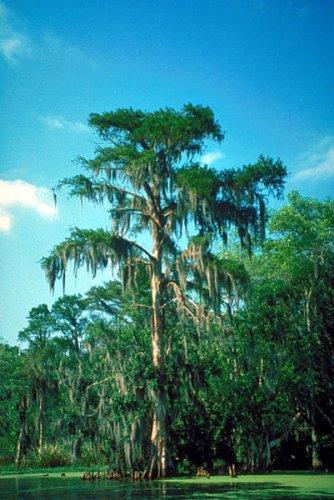Mystery plant 12 is bald cypress. If you know your Mediterranean geography, you probably found this one easy.
You were given these clues:
In the Middle Sea it basks in the sun.
Sicily, Sardinia, and then this one.Elegantly flying at Notre Dame, it serves a function that bears its name.
No locks to adorn, no need to be shorn.
So the patella says to the meniscus, "What's a nice cartilage like you doing in a joint like this?"
Here's how to work this one out.
The Middle Sea is the Mediterranean Sea. The three largest islands in the Mediterranean are Sicily, Sardinia, and Cyprus.
If you have no locks to adorn and no need to be shorn you are bald.
The thing that "elegantly flies at Notre Dame" and serves a function that bears its name is a flying buttress. A buttress is a type of support, and to buttress something is to support or reinforce it. Bald cypress trees that grow in water or in flood-prone areas have buttress flutes that widen the base of the trunk to provide extra support in the waterlogged soil.
The knee is a joint that has a patella (kneecap) for protection and two crescent-shaped cartilage pads (the lateral meniscus and the medial meniscus) for cushioning. Bald cypress trees growing in flooded or flood-prone areas characteristically have "knees," which are porous, low-density woody structures extending upward from the root system to a height above normal water level.
The bald cypress (Taxodium distichum), aka baldcypress or swamp cypress, is a water-loving conifer that primarily grows in wet or flood-prone areas such as ponds, swamps, sloughs, and river bottom floodplains. Although it is one of the iconic trees of the South, where it is commonly draped with Spanish moss, you can find it in the Atlantic Coastal Plain as far north as Delaware and in the Mississippi River Valley as far north as southern Indiana. In the Gulf Coastal Plain, it grows as far west as Texas.
Everglades National Park in Florida, Congaree National Park in South Carolina, and Big Thicket National Preserve in Texas are just three of the many national parks harboring bald cypress.
Cypress wood is fine-grained, watertight, and rot-resistant, making it desirable for making items such as posts, decks, shingles, stadium seats, vats, boats, railroad cars, caskets, and fine cabinetry. Because of commercial logging, relatively few bald cypress get the chance to grow to their maximum age and size. The current national champion, a giant growing in Louisiana's Cat Island National Wildlife Refuge, is 83 feet tall and has a trunk that is 17 feet in diameter and 56 feet in circumference. It is probably 500 or so years old, which is about half the maximum age for a tree of this species.
Postscript: Scientists haven't been able to conclusively determine why bald cypress trees growing in wet locations characteristically have knees (pneumatophores). The notion that that they are needed to oxygenate the tree's waterlogged root system has been discredited, and most experts now believe that the knees function primarily to enhance a tree's stability in wet soils. Many bald cypress trees in better-drained locations do not have knees and do just fine without them.




Add comment